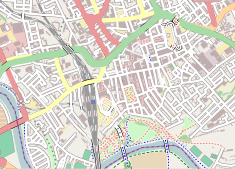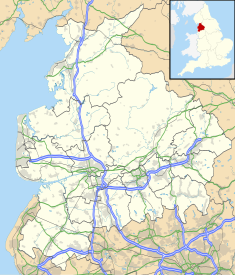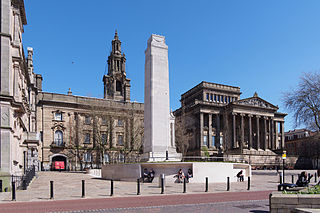
Preston is a city on the north bank of the River Ribble in Lancashire, England. The city is the administrative centre of the county of Lancashire and the wider City of Preston local government district. Preston and its surrounding district obtained city status in 2002, becoming England's 50th city in the 50th year of Queen Elizabeth II's reign. Preston has a population of 114,300, the City of Preston district 132,000 and the Preston Built-up Area 313,322. The Preston Travel To Work Area, in 2011, had a population of 420,661, compared with 354,000 in the previous census.

Fulwood is a suburb of Preston, Lancashire, England, to the north of the city centre. It had a population of 28,535 in 2011 and since 2019, is made up of four electoral wards on the City Council.
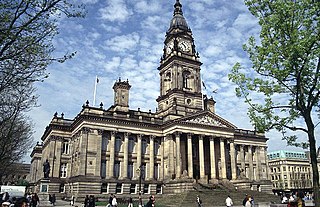
Bolton Town Hall in Victoria Square, Bolton, Greater Manchester, England, was built between 1866 and 1873 for the County Borough of Bolton to designs by William Hill of Leeds and George Woodhouse of Bolton. The town hall was extended in the 1930s to the designs of Bradshaw, Gass and Hope and has been designated a Grade II* listed building by English Heritage.

County Hall is a municipal building in Fishergate, Preston, Lancashire, England. It is the headquarters of Lancashire County Council.

The Old Town Hall, Richmond on Whittaker Avenue in Richmond, London is a former municipal building which from 1893 to 1965 served as the town hall for the Municipal Borough of Richmond.

Blackpool Town Hall is a municipal building in Talbot Square, Blackpool, England. The town hall is the headquarters of Blackpool Council, which is the main governing body for the wider Borough of Blackpool. It is a Grade II listed building.

Burnley Town Hall is a municipal building in Manchester Road, Burnley, Lancashire, England. The town hall, which is the headquarters of Burnley Borough Council, is a Grade II listed building.

Morecambe Town Hall is a municipal building in Marine Road, Morecambe, Lancashire, England. It is a Grade II listed building.

Wakefield Town Hall is a municipal building in Wood Street in Wakefield, West Yorkshire, England. It remains a venue for weddings and civil partnerships but is no longer the headquarters of Wakefield Council which is now based at County Hall. The town hall is a Grade I listed building.

South Shields Town Hall is a Grade II listed building on Westoe Road in South Shields, Tyne and Wear, England. It serves as the headquarters of South Tyneside Council.

Wallsend Town Hall is a municipal building on High Street East in Wallsend, Tyne and Wear, England. The town hall, which was the headquarters of North Tyneside Council from 1974 to 2008, is a Grade II listed building.

Chorley Town Hall is a municipal building in Market Street in Chorley, Lancashire, England.

Darwen Town Hall is a municipal building in Croft Street, Darwen, Lancashire, England. It is the meeting place of Darwen Town Council.

Cleckheaton Town Hall is a municipal building in Bradford Road, Cleckheaton, West Yorkshire, England. The town hall, which was the headquarters of Spenborough Urban District Council, is a Grade II listed building.
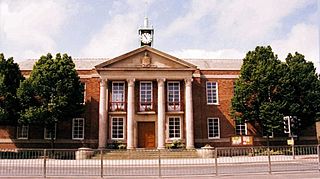
Padiham Town Hall is a municipal building in Burnley Road, Padiham, Lancashire, England. The town hall, which was the headquarters of Padiham Urban District Council, is a grade II listed building. It is the meeting place of Padiham Town Council.

Colne Town Hall is a municipal building in Albert Road, Colne, Lancashire, England. The town hall, which is the meeting place of Colne Town Council, is a grade II listed building.

Royton Town Hall is a municipal building in Rochdale Road, Royton, Greater Manchester, England. The town hall was the headquarters of Royton Urban District Council.
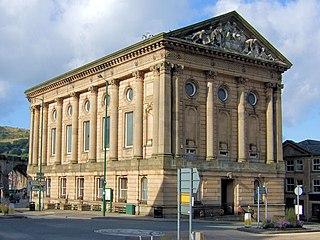
Todmorden Town Hall is a municipal building in Halifax Road, Todmorden, West Yorkshire, England. The town hall, which is the meeting place of Todmorden Town Council, is a grade I listed building.

Nelson Town Hall is a municipal building in Market Square, Nelson, Lancashire, England. The building is the headquarters for both Pendle Borough Council and Nelson Town Council.

The Old Town Hall, sometimes referred to as the Moot Hall, is a municipal building in Church Street, Clitheroe, Lancashire, England. The structure, which was the meeting place of Clitheroe Borough Council, is a Grade II listed building.

